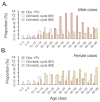Genomic and epidemiological monitoring of yellow fever virus transmission potential
- PMID: 30139911
- PMCID: PMC6874500
- DOI: 10.1126/science.aat7115
Genomic and epidemiological monitoring of yellow fever virus transmission potential
Abstract
The yellow fever virus (YFV) epidemic in Brazil is the largest in decades. The recent discovery of YFV in Brazilian Aedes species mosquitos highlights a need to monitor the risk of reestablishment of urban YFV transmission in the Americas. We use a suite of epidemiological, spatial, and genomic approaches to characterize YFV transmission. We show that the age and sex distribution of human cases is characteristic of sylvatic transmission. Analysis of YFV cases combined with genomes generated locally reveals an early phase of sylvatic YFV transmission and spatial expansion toward previously YFV-free areas, followed by a rise in viral spillover to humans in late 2016. Our results establish a framework for monitoring YFV transmission in real time that will contribute to a global strategy to eliminate future YFV epidemics.
Copyright © 2018, American Association for the Advancement of Science.
Conflict of interest statement
N.J.L. and L.C.J.A. received free-of-charge reagents in support of the project from Oxford Nanopore Technologies.
Figures




Comment in
-
The reemergence of yellow fever.Science. 2018 Aug 31;361(6405):847-848. doi: 10.1126/science.aau8225. Epub 2018 Aug 23. Science. 2018. PMID: 30139914 No abstract available.
-
Monitoring yellow fever.Nat Med. 2018 Dec;24(12):1781. doi: 10.1038/s41591-018-0280-7. Nat Med. 2018. PMID: 30523315 No abstract available.
References
-
- Paules CI, Fauci AS. Yellow Fever - Once Again on the Radar Screen in the Americas. The New England Journal of Medicine. 2017:1397–1399. - PubMed
Publication types
MeSH terms
Grants and funding
LinkOut - more resources
Full Text Sources
Other Literature Sources

